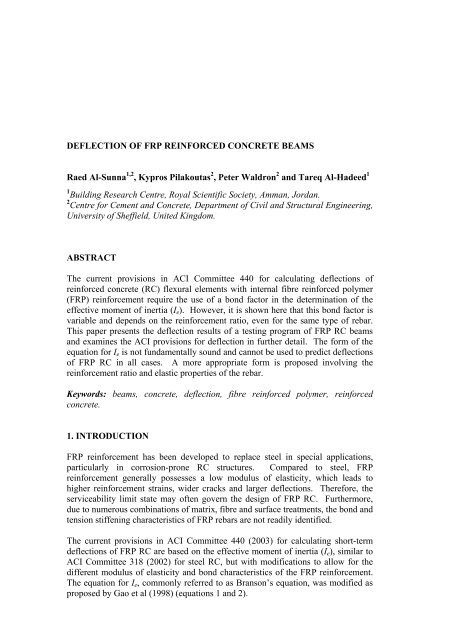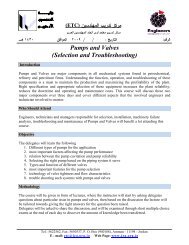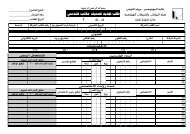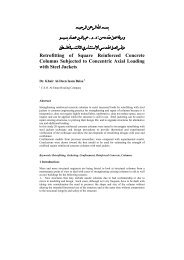DEFLECTION OF FRP REINFORCED CONCRETE BEAMS Raed Al ...
DEFLECTION OF FRP REINFORCED CONCRETE BEAMS Raed Al ...
DEFLECTION OF FRP REINFORCED CONCRETE BEAMS Raed Al ...
You also want an ePaper? Increase the reach of your titles
YUMPU automatically turns print PDFs into web optimized ePapers that Google loves.
<strong>DEFLECTION</strong> <strong>OF</strong> <strong>FRP</strong> <strong>REINFORCED</strong> <strong>CONCRETE</strong> <strong>BEAMS</strong><br />
<strong>Raed</strong> <strong>Al</strong>-Sunna 1,2 , Kypros Pilakoutas 2 , Peter Waldron 2 and Tareq <strong>Al</strong>-Hadeed 1<br />
1 Building Research Centre, Royal Scientific Society, Amman, Jordan.<br />
2 Centre for Cement and Concrete, Department of Civil and Structural Engineering,<br />
University of Sheffield, United Kingdom.<br />
ABSTRACT<br />
The current provisions in ACI Committee 440 for calculating deflections of<br />
reinforced concrete (RC) flexural elements with internal fibre reinforced polymer<br />
(<strong>FRP</strong>) reinforcement require the use of a bond factor in the determination of the<br />
effective moment of inertia (I e ). However, it is shown here that this bond factor is<br />
variable and depends on the reinforcement ratio, even for the same type of rebar.<br />
This paper presents the deflection results of a testing program of <strong>FRP</strong> RC beams<br />
and examines the ACI provisions for deflection in further detail. The form of the<br />
equation for I e is not fundamentally sound and cannot be used to predict deflections<br />
of <strong>FRP</strong> RC in all cases. A more appropriate form is proposed involving the<br />
reinforcement ratio and elastic properties of the rebar.<br />
Keywords: beams, concrete, deflection, fibre reinforced polymer, reinforced<br />
concrete.<br />
1. INTRODUCTION<br />
<strong>FRP</strong> reinforcement has been developed to replace steel in special applications,<br />
particularly in corrosion-prone RC structures. Compared to steel, <strong>FRP</strong><br />
reinforcement generally possesses a low modulus of elasticity, which leads to<br />
higher reinforcement strains, wider cracks and larger deflections. Therefore, the<br />
serviceability limit state may often govern the design of <strong>FRP</strong> RC. Furthermore,<br />
due to numerous combinations of matrix, fibre and surface treatments, the bond and<br />
tension stiffening characteristics of <strong>FRP</strong> rebars are not readily identified.<br />
The current provisions in ACI Committee 440 (2003) for calculating short-term<br />
deflections of <strong>FRP</strong> RC are based on the effective moment of inertia (I e ), similar to<br />
ACI Committee 318 (2002) for steel RC, but with modifications to allow for the<br />
different modulus of elasticity and bond characteristics of the <strong>FRP</strong> reinforcement.<br />
The equation for I e , commonly referred to as Branson’s equation, was modified as<br />
proposed by Gao et al (1998) (equations 1 and 2).
⎡M<br />
⎤<br />
cr<br />
I<br />
e<br />
= I<br />
cr<br />
+ ( β<br />
d<br />
I<br />
g<br />
− I<br />
cr<br />
) ⎢ ⎥ ≤ I<br />
g<br />
(1)<br />
⎢ M a<br />
⎣ ⎥⎦<br />
⎡ E<br />
f ⎤<br />
β<br />
d<br />
= α<br />
b ⎢ + 1⎥<br />
(2)<br />
⎣ Es<br />
⎦<br />
in which I g and I cr are the gross and linear cracked moment of inertia, M cr and M a<br />
are the cracking and applied moment, E f and E s are the <strong>FRP</strong> and steel modulus of<br />
elasticity and α b is a bond dependent coefficient, which equals 0.5 for steel rebars.<br />
A value of 0.5 has also been recommended for all <strong>FRP</strong> rebar types, until more<br />
research data becomes available.<br />
The work presented in this paper is part of an extensive research program on the<br />
flexural behaviour of <strong>FRP</strong> RC elements, which was carried out at the Royal<br />
Scientific Society (Jordan) in collaboration with the University of Sheffield (UK).<br />
The experimental deflection results of twelve <strong>FRP</strong> RC beams are used to examine<br />
the accuracy of those predicted by the approach of ACI committee 440. In<br />
particular, the factors β d (or α b ) in the equation for I e are evaluated. The main<br />
variables considered in the tests are the type of <strong>FRP</strong> rebar and reinforcement ratio.<br />
3<br />
2. EXPERIMENTAL PROGRAM<br />
2.1 Materials<br />
The type of <strong>FRP</strong> rebar is one of the variables in this investigation. Two rebar types<br />
were used: glass (G<strong>FRP</strong>) and carbon (C<strong>FRP</strong>) (Fig. 1). The G<strong>FRP</strong> rebars were<br />
Aslan (100). Their surface treatment may be classified as helically wrapped, sand<br />
coated. During the experimental program, the C<strong>FRP</strong> rebars were still under<br />
development and are currently commercially available as Aslan (200). Their<br />
surface treatment may be classified as helically wrapped, indented. Table 1 shows<br />
the main tensile properties of the <strong>FRP</strong> rebars, as provided by the manufacturer.<br />
The tensile properties of the steel rebars were obtained by testing representative<br />
samples, and are shown in Table 2.<br />
The concrete was produced locally with 25 mm maximum aggregate size, 0.48 free<br />
water to cement ratio and 380 kg/m 3 cement content. The fresh concrete slump was<br />
about 75 mm and the 28-day cube compressive strength was around 35 MPa.<br />
C<strong>FRP</strong> rebar<br />
G<strong>FRP</strong> rebar<br />
Fig. 1: C<strong>FRP</strong> and G<strong>FRP</strong> rebars
Table 1: Tensile properties of <strong>FRP</strong> rebars<br />
Rebar<br />
type<br />
Nominal diameter,<br />
(mm)<br />
Modulus of elasticity,<br />
(MPa)<br />
Guaranteed tensile<br />
strength, (MPa)<br />
9.53 40800 760<br />
G<strong>FRP</strong> 12.70 40800 690<br />
19.05 40800 620<br />
6.35 119750 1250<br />
C<strong>FRP</strong> 9.53 122750 1000<br />
12.70 111750 900<br />
Table 2: Tensile properties of steel rebars<br />
Rebar<br />
type<br />
Nominal<br />
diameter,<br />
(mm)<br />
Modulus of<br />
elasticity,<br />
(MPa)<br />
Yield<br />
strength,<br />
(MPa)<br />
Steel 12 200000 590 675<br />
Ultimate<br />
Strength,<br />
(MPa)<br />
2.2 Test Specimens<br />
The test specimens consisted of three series of G<strong>FRP</strong> and three series of C<strong>FRP</strong> RC<br />
beams. One series of steel RC beams was tested for comparison purposes. To<br />
ensure repeatability, each series comprised two identical beams. The beam series<br />
were designated as BG#, BC# or BS#. B stands for beam; # is the series number;<br />
while G, C and S refer to G<strong>FRP</strong>, C<strong>FRP</strong> and steel rebars, respectively. The two<br />
identical beams, within each series, were identified by adding a or b to the series<br />
name. The beams were 150 mm wide, 250 mm high, 2550 mm long, with the<br />
distance between the end-supports being 2300 mm (Fig. 1). <strong>Al</strong>l beams were tested<br />
under four-point loading. The shear span was 767 mm (one third of the beam<br />
span). The shear span was reinforced with steel stirrups to avoid shear failure,<br />
while the midspan was free of stirrups. Nominal 6mm G<strong>FRP</strong>, C<strong>FRP</strong> or steel rebars<br />
were used at the top within the shear span to hold the stirrups. The clear concrete<br />
cover to the rebars was 25 mm in all cases.<br />
The two beams in each series, along with eight control cubes and eight control<br />
cylinders were constructed from the same batch of in-situ concrete. The beams and<br />
control specimens were cured under similar conditions. The cubes were used to<br />
determine the compressive strength, while the cylinders were used to determine the<br />
split cylinder tensile strength of the concrete on the day of testing the beam.<br />
In addition to the type of rebar, the other variable in this study is the reinforcement<br />
ratio. The G<strong>FRP</strong> and C<strong>FRP</strong> beams were designed to have equal flexural capacity,<br />
equal area of rebars or equal stiffness of rebars, to the steel control beams.<br />
Thereby, for each type of rebar, a wide range of reinforcement ratios was required<br />
and several rebar diameters were used. The resulting sections were underreinforced,<br />
close to balanced or over-reinforced, with failure occurring by rupture<br />
of bars or crushing of concrete. The geometric and reinforcement details of the test<br />
beams are shown in Table 3 and Fig. 2.
Table 3: Geometric and reinforcement details of the test beams<br />
Rebar<br />
type<br />
Series<br />
designation<br />
Beam<br />
designation<br />
Rebar<br />
details<br />
Reinforcement<br />
ratio<br />
Relation to control<br />
steel beam<br />
BG1<br />
BG1a<br />
Equal flexural<br />
2∅9.53 0.00432<br />
BG1b<br />
capacity<br />
G<strong>FRP</strong> BG2<br />
BG2a<br />
Equal area of<br />
2∅12.7 0.00772<br />
BG2b<br />
rebars<br />
BG3<br />
BG3a<br />
Equal stiffness of<br />
4∅19.05 0.0391<br />
BG3b<br />
rebars<br />
BC1<br />
BC1a<br />
Equal flexural<br />
3∅6.35 0.00286<br />
BC1b<br />
capacity<br />
C<strong>FRP</strong> BC2<br />
BC2a<br />
Equal area of<br />
3∅9.53 0.00648<br />
BC2b<br />
rebars<br />
BC3<br />
BC3a<br />
Equal stiffness of<br />
3∅12.7 0.0116<br />
BC3b<br />
rebars<br />
Steel BS<br />
BSa<br />
BSb<br />
2∅12 0.00688 -<br />
2Ø6mm<br />
stirrups,<br />
Ø8mm/75mm<br />
250<br />
125<br />
767<br />
766 767<br />
125<br />
2300<br />
150<br />
2Ø6mm<br />
250<br />
stirrups,<br />
Ø8mm/75mm<br />
25mm<br />
cover to bars<br />
Fig. 2: Geometric and reinforcement details of the test beams<br />
2.3 Test Procedure<br />
<strong>Al</strong>l beams were tested under four-point loading (Fig. 3). The load was applied<br />
centrally by a 600 kN hydraulic jack, and a distribution beam was used to distribute<br />
the load to the two third-span points. Two dial gauges were used to measure<br />
settlements at the end supports. Five linear variable displacement transducers<br />
(LVDT) were used to measure deflections at the third- points of one shear span, at<br />
the two loading points and at midspan. One LVDT was used to measure the<br />
average strain and the crack width at the level of the reinforcement. In addition,<br />
one strain gauge was used to measure the top fibre concrete strain at midspan.<br />
Though not discussed in this paper, one of the aims of this study was to investigate<br />
the effect of tension stiffening on deflection and cracking. Therefore, a crack<br />
inducer, (20 x 0.6) mm, was used to ensure that a crack would occur at midspan.<br />
Then, a total of ten closely-spaced strain gauges were used to measure rebar strains
on either side. Thus, it was possible to obtain strain profiles between one forced<br />
crack at midspan and two contiguous natural cracks. Four additional strain gauges<br />
were used to measure rebar strain at one loading point, at the third-points of one<br />
shear span, and at one support.<br />
The testing was carried out using load control. The load was increased at a rate of<br />
1 kN/min and was paused at about 5 kN intervals to mark and measure the cracks<br />
and to take notes. Two load cycles were performed. In the first cycle, the load was<br />
increased to a service load level, which corresponded to a stress of about 45% the<br />
concrete compressive strength in the top concrete fibre at midspan. In the second<br />
cycle, the load was increased until failure occurred, either by rupture of bars or by<br />
crushing of concrete. <strong>Al</strong>l data (force, strains and deflections) were collected by a<br />
data acquisition system, and downloaded to a PC every one second.<br />
Hydraulic Jack<br />
LVDT<br />
Distribution Beam<br />
LVDT Locations<br />
Strain Gauge on Rebar<br />
Strain Gauge on concrete<br />
Midspan forced crack<br />
Natural crack<br />
Natural crack<br />
90 90<br />
Strain Gauge Locations<br />
Fig. 3: Typical beam test setup.<br />
3. TEST RESULTS AND DISCUSSION<br />
Fig. 4 and 5 show the experimental load-deflection response at midspan for all<br />
beams. From these figures, it is clear that the results of the two replicate beams<br />
within each series are rather identical. A small difference in the initial deflections<br />
is noticed in the BS series, but this is because beam BSb was accidentally preloaded<br />
and pre-cracked before testing. Therefore, it can be confirmed that the<br />
materials used, the production of the beams and the test procedure were all well<br />
controlled. It is also clear that the test results reasonably satisfy the relation of the<br />
<strong>FRP</strong> to the control steel reinforced beams, as initially designed, except for series
BG1 where the G<strong>FRP</strong> rebars ruptured prematurely. This indicates, that the<br />
manufacturer tensile material properties of the <strong>FRP</strong> rebars are also reasonable,<br />
particularly the supplied modulus of elasticity. Nevertheless, for a more refined<br />
analysis of the results, tensile tests of representative <strong>FRP</strong> rebar samples are<br />
currently underway.<br />
140<br />
Beams BG, BS<br />
120<br />
100<br />
Force [kN]<br />
80<br />
60<br />
40<br />
20<br />
BG1a<br />
BG1b<br />
BG2a<br />
BG2b<br />
BG3a<br />
BG3b<br />
BSa<br />
BSb<br />
0<br />
0 5 10 15 20 25 30 35 40 45 50<br />
Midspan Deflection [mm]<br />
Fig. 4: Experimental force vs. midspan deflection – series BG and BS<br />
140<br />
Beams BC, BS<br />
120<br />
100<br />
Force [kN]<br />
80<br />
60<br />
40<br />
20<br />
BC1a<br />
BC1b<br />
BC2a<br />
BC2b<br />
BC3a<br />
BC3b<br />
BSa<br />
BSb<br />
0<br />
0 5 10 15 20 25 30 35 40<br />
Midspan Deflection [mm]<br />
Fig. 5: Experimental force vs. midspan deflection – series BC and BS<br />
The experimental midspan deflections for every beam series are compared to<br />
predicted deflections in Figs. 6 to 8.
50<br />
45<br />
40<br />
35<br />
Beam BG1a<br />
β d =0.09<br />
(α b =0.07)<br />
Force [kN]<br />
30<br />
25<br />
20<br />
15<br />
10<br />
5<br />
0<br />
BG1a<br />
ACI 318 (2002)<br />
ACI 440 (2003)<br />
linear cracked section<br />
proposed equations 4<br />
0 5 10 15 20 25 30 35 40 45<br />
Midspan Deflection [mm]<br />
90<br />
80<br />
70<br />
60<br />
Beam BG2a<br />
β d =0.15, ( α b = 0.12)<br />
Force [kN]<br />
50<br />
40<br />
30<br />
20<br />
10<br />
0<br />
BG2a<br />
ACI 318 (2002)<br />
ACI 440 (2003)<br />
linear cracked section<br />
proposed equation 4<br />
0 5 10 15 20 25 30 35 40 45 50<br />
Midspan Deflection [mm]<br />
120<br />
100<br />
Beam BG3a<br />
β d =0.5,<br />
(α b =0.41)<br />
80<br />
Force [kN]<br />
60<br />
40<br />
20<br />
BG3a<br />
ACI 318 (2002)<br />
ACI 440 (2003)<br />
linear cracked section<br />
proposed equation 4<br />
0<br />
0 5 10 15 20 25<br />
Midspan Deflection [mm]<br />
Fig. 6: Experimental and predicted deflections – G<strong>FRP</strong> Beams.
80<br />
70<br />
60<br />
Beam BC1a<br />
β d = 0.19 (α b =0.12)<br />
Force [kN]<br />
50<br />
40<br />
30<br />
20<br />
10<br />
BC1a<br />
ACI 318 (2002)<br />
ACI 440 (2003)<br />
Linear cracked section<br />
proposed equation 4<br />
0<br />
0 5 10 15 20 25 30 35 40 45<br />
Midspan Deflection [mm]<br />
120<br />
100<br />
Beam BC2a<br />
β d = 0.25 (α b =0.15)<br />
80<br />
Force [kN]<br />
60<br />
40<br />
20<br />
proposed equation 4<br />
BC2a<br />
ACI 318 (2002)<br />
ACI 440 (2003)<br />
Linear cracked section<br />
proposed equation 4<br />
0<br />
0 5 10 15 20 25 30 35<br />
Midspan Deflection [mm]<br />
140<br />
120<br />
Beam BC3a<br />
β d = 0.5 (α b =0.32)<br />
100<br />
Force [kN]<br />
80<br />
60<br />
40<br />
20<br />
proposed equations 4<br />
BC3a<br />
ACI 318 (2002)<br />
ACI 440 (2003)]<br />
linear cracked section<br />
proposed equations 4<br />
0<br />
0 5 10 15 20 25<br />
Midspan Deflection [mm]<br />
Fig. 7: Experimental and predicted deflections – C<strong>FRP</strong> Beams.
80<br />
70<br />
Beam BSa<br />
60<br />
Force [kN]<br />
50<br />
40<br />
30<br />
BSa<br />
ACI 318 (2002) and<br />
proposed equations (4, 5)<br />
linear cracked section<br />
20<br />
10<br />
0<br />
0 5 10 15 20 25 30<br />
Midspan Deflection [mm]<br />
Fig. 8: Experimental and predicted deflections – Steel Beams.<br />
As may be expected, the original Branson’s equation for I e , results in rather<br />
accurate deflection predictions for the control steel beams. On the contrary, it<br />
underestimates deflections of all <strong>FRP</strong> beams. However, as the reinforcement ratio<br />
increases, the predicted deflections are better. In fact, for beam series BG3 and<br />
BC3, which have the highest reinforcement ratios, the deflections are acceptable,<br />
though still underestimated. This confirms the conclusion of Toutanji and Saafi<br />
(1999) who proposed using Branson’s equation when [ ρ ( E / E ≥ 0.3]<br />
, where ρ f<br />
is the percentage reinforcement ratio. Similarly, Wei et al (1997) recommended no<br />
modification to Branson’s equation, but without imposing any limits on the<br />
reinforcement ratio. It is clear that there is a need to modify Branson’s equation,<br />
particularly for low reinforcement ratios, and it seems reasonable that the<br />
reinforcement ratio should appear in the equation for I e .<br />
The coefficient β d in the ACI Committee 440 equation for I e has been determined<br />
for all beam series, so that the predicted deflections compare best to the<br />
experiments. The resulting β d (or α b ) vary widely, and increase with reinforcement<br />
ratio, as shown also in Table 4. Had the proposed ACI approach been adequate, a<br />
unique value would have resulted for the coefficient β d (or α b ) for each <strong>FRP</strong> rebar<br />
type, irrespective of the reinforcement ratio or the rebar diameter. Besides, for the<br />
C<strong>FRP</strong> beams, the deflections predicted are not as good as for the G<strong>FRP</strong> beams.<br />
Moreover, the currently proposed 0.5 value for α b underestimates deflections,<br />
particularly for low reinforcement ratios. Therefore, the current ACI Committee<br />
440 approach for evaluating I e does not seem to be applicable in all cases. This<br />
implies that the bond characteristics may need to be accounted for in a different<br />
way. For that purpose, analytical work is underway to investigate the relation<br />
between deflection behaviour and the rebar strain profiles between cracks due to<br />
tension stiffening. Yet again, the inclusion of the reinforcement ratio in the<br />
equation for I e may be necessary.<br />
f<br />
f<br />
s
Table 4: Calibrated coefficients β d or α b proposed in ACI Committee 440<br />
Rebar Type G<strong>FRP</strong> C<strong>FRP</strong><br />
Beam Series BG1 BG2 BG3 BC1 BC2 BC3<br />
Coefficient β d 0.09 0.15 0.5 0.19 0.25 0.5<br />
Coefficient α b 0.07 0.12 0.41 0.12 0.15 0.32<br />
ACI Committee 440 equation for I e actually provides a smooth transition between<br />
the gross and linear cracked moments of inertia, I g and, eventually converging with<br />
I cr . However, the figures show that the experimental deflections exceed the I cr limit<br />
on deflections. This indicates that the composite action between the concrete and<br />
<strong>FRP</strong> rebars may not be as perfect as assumed. This also means that the form of the<br />
equation for I e should provide a transition between I g and a certain fraction of I cr .<br />
Such an equation was proposed by Benmokrane et al (1996), but with very specific<br />
coefficients for their particular tests (equation 3).<br />
I<br />
g ⎡M<br />
cr<br />
⎤<br />
I<br />
e<br />
= α I<br />
c<br />
+ ( −αI<br />
c<br />
)<br />
r<br />
r ⎢ ⎥ (3)<br />
β ⎣ M<br />
a ⎦<br />
in which α and β were evaluated as equal to 0.84 and 7, respectively.<br />
3<br />
Equation 3 has better fundamentals than the current ACI equation. The factor α<br />
reflects the reduced composite action between the concrete and <strong>FRP</strong> rebars, as<br />
discussed above. However, the factor β has no physical significance since there is<br />
no justification for reducing I g . Nevertheless, its introduction in the equation is<br />
necessary because it enables a faster transition from I g to I cr , since the degradation<br />
in stiffness due to the 3 rd power component is very slow. However, a more general<br />
equation is needed that takes into account the type and amount of reinforcement.<br />
Considering the experimental results of all beam series, the factor β has been<br />
modified and expressed as an exponential function of the reinforcement ratio (ρ)<br />
and the <strong>FRP</strong> modulus of elasticity (E f ). Therefore, it is proposed to use a more<br />
general form of equation 3 as follows.<br />
I<br />
e<br />
3<br />
⎡M<br />
cr<br />
⎤<br />
= α I<br />
c<br />
+ ( βI<br />
g<br />
−αI<br />
c<br />
)<br />
r<br />
r ⎢ ⎥ (4)<br />
⎣ M<br />
a ⎦<br />
1.2<br />
330( ρE / )<br />
0.1<br />
f E<br />
β = e<br />
s<br />
(5)<br />
Fig. 6, 7 and 8 show that the deflections predicted by equation 4 are generally in<br />
very good agreement with the test results, even in the case of steel reinforcement.<br />
α−values of 0.9, 0.85 and 1.0 have been used for G<strong>FRP</strong>, C<strong>FRP</strong> and steel RC<br />
beams, respectively. The factor α depends on the rebar bond characteristics and<br />
needs further investigation.<br />
Furthermore, the generality of equation 5 has been tested by applying it to the two<br />
<strong>FRP</strong> beam series of Benmokrane et al (1996), which was a totally different testing<br />
program from the one used to derive the equation, with different <strong>FRP</strong> rebars, beam<br />
dimensions and material properties. The resulting β values are 0.11 and 0.13,<br />
which agree well with the 1/7 value proposed in equation 3.
4. CONCLUSIONS<br />
From the experimental and analytical work presented in this paper, the following<br />
may be concluded.<br />
1. The original Branson’s equation for I e works well for steel RC, but<br />
overestimates the actual I e and underestimates deflections of <strong>FRP</strong> RC.<br />
2. The form of the equation for I e , proposed by ACI Committee 440, is not<br />
fundamentally sound and cannot be used to predict deflections of <strong>FRP</strong> RC in all<br />
cases.<br />
3. A more general form of the equation for I e is proposed by modifying the<br />
equation adopted by Benmokrane et al (1996). The reinforcement ratio is<br />
introduced as a new variable and I cr is reduced by a factor α, which is a bond<br />
dependent coefficient that reflects the degree of concrete-reinforcement<br />
composite action.<br />
4. More research work is required to investigate the accuracy of the proposed<br />
equation.<br />
ACKNOWLEDGEMENTS<br />
The authors wish to acknowledge the financial support provided by The Higher<br />
Council for Science and Technology (Jordan), the Royal Scientific Society<br />
(Jordan), the Centre for Cement and Concrete,University of Sheffield (UK) and the<br />
Karim Rida Said Foundation (UK).<br />
REFERENCES<br />
ACI Committee 318 (2002): “Building Code Requirements for Structural<br />
Concrete (ACI 318-02) and Commentary (ACI 318R-02),” American Concrete<br />
Institute, Farmington Hills, Mich, 367 pp.<br />
ACI Committee 440 (2003): “Guide for the Design and Construction of Concrete<br />
Reinforced with <strong>FRP</strong> Bars (ACI 440.1R-01),” American Concrete Institute,<br />
Farmington Hills, Mich, 42 pp.<br />
Benmokrane, B.; Chaallal, O.; Masmoudi, R. (1996): “Flexural Response of<br />
Concrete Beams Reinforced with <strong>FRP</strong> Reinforcing Bars,” ACI Structural Journal,<br />
Vol. 93, No. 1, Jan.-Feb., pp. 46-55.<br />
Gao, D.; Benmokrane, B.; Masmoudi, R. (1998): “A Calculating Method of<br />
Flexural Properties of <strong>FRP</strong>-Reinforced Concrete Beam: Part 1: Crack Width and<br />
Deflection,” Technical Report, Department of Civil Engineering, University of<br />
Sherbrooke, Sherbrooke, Quebec, Canada, 24 pp.
Toutanji, H. A.; Saafi M. (1999): “Deflection and Crack Width Predictions of<br />
Concrete Beams Reinforced with Fiber Reinforced Polymer Bars,” Proceedings,<br />
Fourth International Symposium on Fiber Reinforced Polymer Reinforcement for<br />
Reinforced Concrete Structures, Baltimore-USA, SP 188, Charles W. Dolan, Sami<br />
H. Rizkalla, and Antonio Nanni, editors, American Concrete Institute, Farmington<br />
Hills, Mich., 1999, pp.1023-1034.<br />
Wei Z., Pilakoutas K., and Waldron P. (1997): “<strong>FRP</strong> Reinforced Concrete:<br />
Calculations for Deflections,” Proceedings of the Third International Symposium<br />
on Non-Metallic (<strong>FRP</strong>) Reinforcement for Concrete Structures, Sapporo-Japan,<br />
Oct. 1997, Vol. 2, pp. 511-518.









